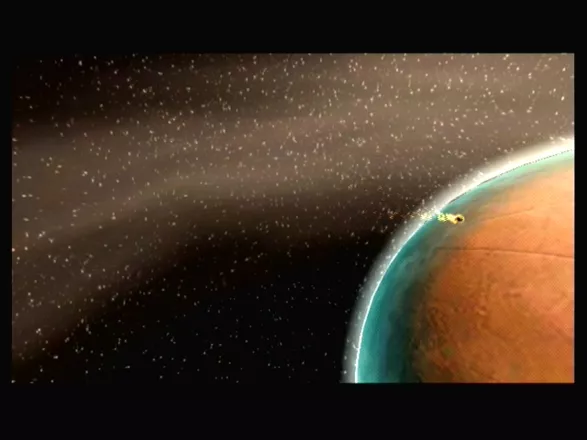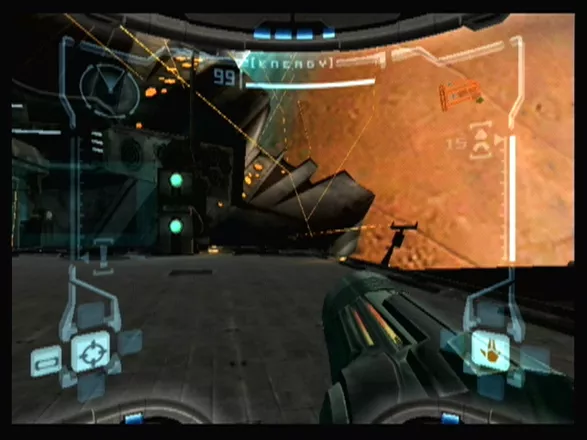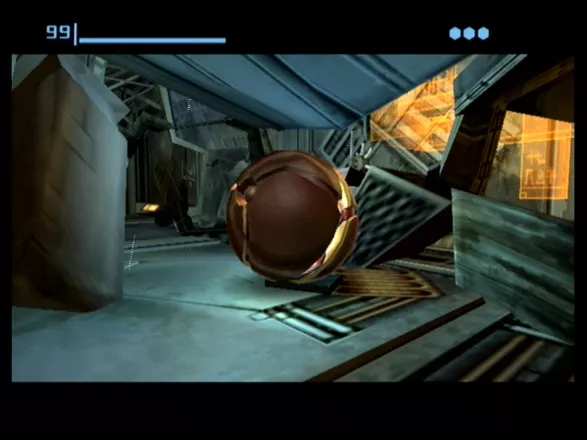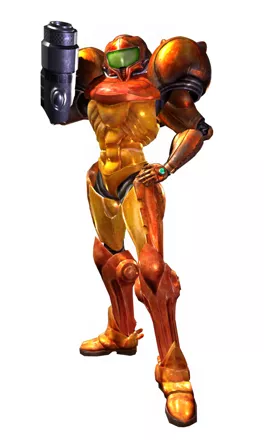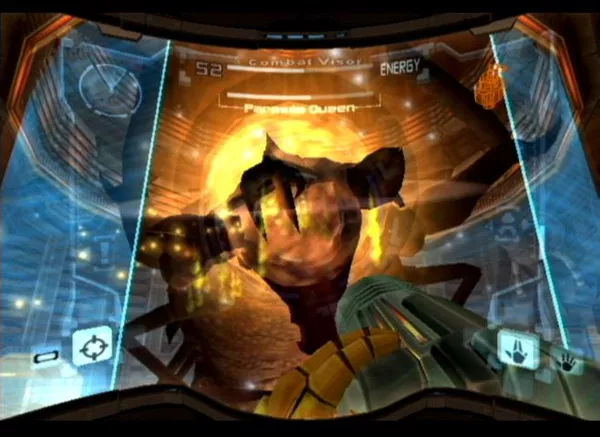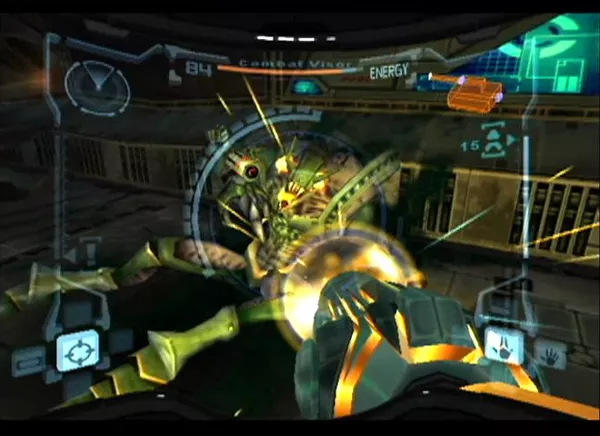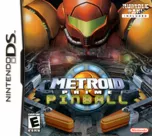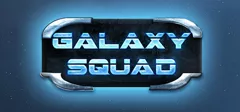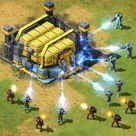Metroid Prime
Description official descriptions
Long ago, a bird-like race of creatures (called the Chozo) became extremely advanced technologically, but due to increasing violence in the universe, they began to hide and live more simple lives. The planet Tallon IV was the site of one of their colonies. Years later, a meteor crashed on Tallon IV releasing the strange element Phazon into the planet. Phazon poisoned anything it came in contact with, causing the plant and animal life to either die or mutate into a hideous form.
The Chozo tried to control the power of Phazon but failed. Before abandoning the planet, they were able to cover the impact crater with a temple and seal Phazon into the planet's core. Now space pirates have discovered Tallon IV, moving in to study Phazon and harnessing its power. They have also begun rebuilding their fortress on planet Zebes and reviving the Mother Brain, Ridley, and Kraid, all of whom were destroyed by Samus Aran. However, Samus has tracked the space pirates to Tallon IV and must now enter the planet to destroy them once and for all before they have a chance to rebuild their destructive forces...
Metroid Prime is a change from the platform-adventuring series, entering the first-person shooter genre for the first time. Players are now behind Samus Aran's visor and must use all their resources to investigate the pirate infestation of Tallon IV. Players can use Samus's beam, with missile and charge capabilities. Along the way, they must recover the bounty hunter's lost abilities like the morph ball and grapple beam, which allow them to reach unexplored areas of Tallon IV. Players must piece together the story of the fallen Chozo to figure out what has happened to the poisoned planet and prevent the pirates from using the Phazon to wreak havoc throughout the planets.
Spellings
- メトロイドプライム - Japanese spelling
- 银河战士 - Chinese spelling (simplified)
- 메트로이드 프라임 - Korean spelling
Groups +
Screenshots
Promos
Videos
Add Trailer or Gameplay Video +1 point
See any errors or missing info for this game?
You can submit a correction, contribute trivia, add to a game group, add a related site or alternate title.
Credits (GameCube version)
123 People (101 developers, 22 thanks) · View all
| Executive Producer | |
| Producer | |
| Lead Designer | |
| Senior Designers | |
| Designers | |
| Lead Engineer | |
| Technical Lead Engineers | |
| Senior Engineers | |
| Engineers | |
| Lead Artist | |
| Senior Artists | |
| [ full credits ] | |
Reviews
Critics
Average score: 96% (based on 94 ratings)
Players
Average score: 4.1 out of 5 (based on 229 ratings with 16 reviews)
The Good
The Wii version got rid of the cumbersome GameCube controls. Now you can aim and move normally with the Wii-mote + Nunchuk combination. You point at your TV to aim and look around. Your movement is very natural, like you are in Samus's suit yourself. There is no reason to go back to the GameCube version. The Wii controls are superior in every way.
The C button for the Morph Ball is particularly genius. The button itself looks just like that -- a small ball.
Metroid Prime is a First-Person Shooter but the more accurate description is "Double Jumping Shooter". Why? Because, in Metroid Prime you will get this item called "Space Jump", and Super Metroid fans will be disappointed. It's not a Space Jump. It's actually a Double Jump. Once you receive this ability, you will realize two things. You will realize why some platforms were just out of reach -- you need to jump twice to reach it! And you realize that from this moment on, double jumping will be what this game is ALL about.
You will be double-jumping in Metroid Prime all the time. It's addictive. Unlike most FPS games, Metroid Prime doesn't care about your weapons. You have four types of beams, with only cosmetic differences. You will not get any Uber-weapons as you would in Halo games. No. Metroid Prime is all about jumping. And why? Because Metroid Prime is the sequel to a side-scrolling platform game. Jumping around and reaching a previously unreachable area is the gameplay we're talking about here.
This is fairly common in 2D shooters, but very rare in 3D first-person shooters. There are a very small number of FPS games that say to you, "Don't bother to kill the enemies; ignore them. All you need to do is jump to this door/ledge/cave/whatever". You are often in a huge room and need to go from point A and get to point B in this same room. This formula is rehashed in the X360 hit Portal 2. There are many ridiculous, epic and exhilarating jumps in Portal 2, but if you've played Metroid Prime, you know that feeling already.
Other than the jumping, the most prominent distinction of Metroid Prime (as opposed to other FPS's) is that your character is VERY strong. You can kill most enemies without even trying. It's very easy to stay alive. The Halo formula of "die, respawn at checkpoint, survive until the next checkpoint" is unheard of here. You will only die a few times throughout the game. Metroid Prime's challenge isn't survival. It is "be careful not to fall". It is still challenging, and it still offers a great deal of satisfaction after you complete something.
One thing about the level design: It is now possible to die in a Save Room. I almost died in a Save Room once, and almost died in a room directly next to a Save Room once too. It's one of those moments in gaming you never forget. Words cannot describe the joy when you're almost dead and discover a Save Room, and actually save in it.
The Bad
** The X-Ray Visor. Oh, the X-Ray Visor. Super Metroid fans will be disappointed. Metroid Prime's designers decided that the X-Ray Visor cannot be used to find hidden items. If there's an item right in front of you, and you switch to the X-Ray Visor, chances are that you will NOT see it.
What does the X-Ray Visor do then, you ask?
-
The X-Ray graphics are kinda cool. Metroid Prime is a very atmospheric adventure and cool graphics like this are always appreciated.
-
The X-Ray Visor is required to see invisible platforms. This is quite lame.
** The Wii version removed the original Metroid game.
** Music isn't memorable. The only tune I can remember is the Lower Norfair theme from Super Metroid.
** No real desire to achieve 100%. I finished the game at 94%(item) and 94%(logbook) and felt content. The problem is that there is no way to know which item you DON'T have. I have read the Metroid Recon guide a few times and still haven't figured out which items I'm missing.
** The #1 annoying element of Metroid Prime: Boost Ball / Half-pipes. It seems to be inspired by the Speed Booster in Super Metroid, but while Speed Booster was the highlight of that game, Boost Ball/Half-pipes are a giant failure here. They are a chore to go through every time.
The Bottom Line
Expect the need to use a walkthrough from time to time. Metroid Prime is Super Metroid + Halo, and it's often the best of the both worlds.
Wii · by Pagen HD (146) · 2014
Through the eyes of a bounty hunter.
The Good
After eight years of hiatus, Metroid returned in a big way. On the same day in 2002, Metroid Fusion for the Gameboy Advance and Metroid Prime for the Gamecube were released in North America. Fusion was a traditional sidescroller developed internally at Nintendo and closely follows the gameplay of Super Metroid. Prime, on the other hand was given off to the unproven western developer, Retro Studios, and flipped into the first-person perspective. In a post-Halo world, much of the fanbase was worried that the focus would be changed to be more action oriented. It’s possible that Nintendo also lacked confidence in the results, as Metroid Fusion contained an introduction that labeled it “Metroid 4”, while Metroid Prime was given no such status within the series. Nowadays, however, gamers tend to look more favourably on Retro’s work, and for good reason.
Despite the drastic change in perspective, Metroid Prime draws heavy inspiration from Super Metroid and largely ignores the features that are typically found in conventional first-person shooters. Perhaps the most disorienting is that it doesn’t use a dual analogue control scheme. Instead, the Y-axis is locked during movement and only by using the free-look button can you actually look up and down. Combat instead uses a lock-on system, rather than allowing free aiming. This, along with the game’s meagre selection of weapons, limits combat to a secondary role and helps the game push its exploration focus.
Like previous Metroid games, the game world is a large web of rooms and other nodes connected together. Progression is limited by what upgrades have been picked up, so certain doors will be impassable until a specific arm cannon upgrade can be found. It really does feel like Super Metroid with an additional dimension to the point where it sometimes feels like it’s reading off the same script. Many of the power-ups from the previous games can be once again found here, with few additions to actually take advantage of the extra dimension. Likewise, the game’s minimalistic story features numerous settings and obstacles that are repeats from the series’ seminal entry.
Metroid’s lore has always been rather disconnected and abstract which makes it difficult to get a handle on how things work. The space pirates, for example, are a race of sentient creatures vying for galactic dominance, yet they were always depicted as sluggish, dimwitted, and extremely vulnerable, and it was hard to believe that they’d have the ambition to build an empire, let alone weaponize a creature such as the Metroid. Metroid Prime does a decent job of making the space pirates a more rounded threat. They’re depicted as an amoral, technologically advanced, militarized society. You can learn a lot about the world, the backstory, and what you’re up against using logs that are read by scanning terminals and enemies with Samus’ visor. There’s an awful lot of text, much of it disposable, littered throughout the game, but it does a good job of adding depth to the space pirates’ organization while dropping a selection of five-dollar words for that added sci-fi effect. For the first time, there’s a lot of context to what’s going on and it really adds some useful perspective to the events in the game.
At the time of its release, and even throughout the Gamecube’s lifespan, Metroid Prime was considered to be quite the graphical powerhouse. By today’s standards, it has lost its dazzle, featuring blocky environments and low resolution textures, but at the time it was rather impressive. However, one part of its visual design that hasn’t aged is its attention to detail. The HUD in particular is creatively done, bordered by the edges of Samus’ visor to give the impression of looking out through her eyes. That’s not necessarily anything new, but it also reacts to environmental effects to further cement the illusion. Rain beads on it, vapour sticks to it, and if there’s a bright flash nearby, the image of Samus’ eyes appears reflecting in the glass as she looks around. While this is all greatly superficial, it’s a rather impressive attempt to further immersion, and there are many other small details like this that add to it.
The Bad
While Metroid Prime was quite the looker in its day, it came at a price in the scope of its environments. Prime’s world boils down collection of nodes and corridors, which is fine since that’s the sort of structure that previous games featured. However, the effect that it does have is that Talon IV doesn’t feel like a real place. While the topology is a little strange, demonstrating a variety of biomes in ridiculously close proximity to one another, it’s not the only reason for the preposterousness of its world. There’s nothing to really give you an idea of how everything links up. If it wasn’t for the map, keeping a sense of direction would be nearly impossible. The map screen itself shows an abstract honeycomb when zoomed out, rather than a view of the overworld, and it’s difficult to place everything together mentally. This could have been solved by giving the player a view of the world from a high place, or having Phendrana Drifts visible in distant mountains and the Phazon Mines from atop a cliff, but no effort was made to tie everything together believably, making the world feel tangibly phoney.
Considering the game plays out entirely in the first-person perspective and a lot of attention has been given into the visor to make it actually appear as though the game is played out through Samus’ eyes, it’s a little unfortunate that Prime still falls into the old standards of establishing shots. Cutscenes are pretty rare, but when a new environment or particular enemy is introduced, the game cuts away to show Samus standing rigidly on the doorstep as she looks around. Obviously, this doesn’t have much of an impact on gameplay aside from taking the player out of the moment, but I feel that the camera should have never left Samus’ helmet.
There’s a lot of backtracking late in the game; more than usual for a Metroid game. The worst example of this occurs towards the end of the game where you’re required to collect a number of artefacts to reach the final area. There are some very specific hints available that reveal their positions, but it’s still necessary to walk across hell’s half-acre to actually reach them. Some can be picked up as you go throughout the game, but others require you to have a vast collection of power-ups before you can reach them. This isn’t a major ordeal, but it is the weakest portion of the game by far. It reduces the game’s already sluggish pace to a glacial crawl as you hop around the environment on a treasure hunt.
The Bottom Line
I replayed Metroid Prime and Metroid Fusion in tandem and came to the conclusion that while I enjoyed Metroid Fusion more than I did previously, I enjoyed Metroid Prime less. It’s not that I didn’t enjoy Prime, it’s an OUTSTANDING game, but in my youth, I loved it. Metroid Prime never really reaches the high points of Super Metroid, but it still delivers a pretty tight experience. The atmosphere is excellent and the attention to detail is almost peerless. It’s commendable that Retro was able to translate the exploration based gameplay of the earlier sidescrollers so deftly to the third dimension. I have my doubts that any other developer will meet with the same success that was found here when it comes to translating the Metroid series to 3D.
GameCube · by Adzuken (836) · 2015
In Tallon IV, one of the greatest games ever is born.
The Good
You play Samus Aran, a female bounty hunter who must investigate the "Great Poison" released throughout Chozo Ruins, which is among four different planets connected to Tallon Overworld through elevators.
The gameplay in this game is completely revolutionary. It's in First Person, but is in no way a first person shooter. Nintendo's given moniker of a FPA is about the best way to put it. I won't give the story here, as this review is long enough as it is. You can check the plot details to find it out. The game works like your usual FPS, only much better. A shoots, and B jumps. X and Y do other functions, such as the morph ball and missiles. What makes things better is that as she goes on, Samus unlocks new weapons and abilities, true to any Metroid game. However, this time, all her weapons remain accessible and usable, with just a swift jolt of the C-Stick, you can switch from the Power Beam, Plasma Beam, Ice Beam, and Wave Beams. Another great feature about the game is that Samus can switch between scan visors. In the beginning of the game you start out with just two visors, the combat visor, which is your normal view-screen, and the scan visor, which allows you to scan objects and enemies, and details most of the plot for you. It can also tell you enemy weaknesses. That's just one of the many things I like about this title. The story is very profound and immersive, but almost none of it progresses during the actual game. You can choose to scan around, learning more and more about what happened here. You can also choose to remain completely oblivious to the events that occurred on Tallon IV. This really adds some more atmosphere and makes the game even more immersive. Even looking up and down is extremely immersive. It would seem clunky at first, then you realize that Samus is in a very heavy suit. Speaking of immersive, this game carries it in spades. You can go anywhere, and mess with almost all of the environment and its creatures. This game is very open-ended…perhaps the most open-ended game I've ever played, allowing you millions of different ways to go about getting the next item on your list. However you like to think, Metroid Prime definitely supports it, and for someone with ANYTHING stimulating their brain cells, this game should definitely be for them. The graphics in this game are among the best ever burned onto a disc or stuffed into a cartridge. Everything is beautiful and extremely accurate and realistic to their certain area. Every villain is drawn wonderful, to the smallest detail, and the areas are perhaps the most beautiful things I've ever seen. Upon landing on Tallon IV I was shaken by just how beautiful the over-world looked. The tropical rains, the lush green forests, and the fact that as I stood in the water and looked into the churning waterfall Samus' face would actually get wet and fog. Magmoor Caverns are the same way. You step into a stream of hot water vapor and you vision wavers and fogs. Phendrana Drifts is perhaps the second most beautiful area I've seen in a game. The perpetual light snow, and those ever-white snowcaps. They just make me want to touch the screen. And the best thing of all? I didn't have a progressive scan cable. The progressive scan cable makes the graphics much sharper than before. Trust me that is a good thing. The soundtrack and sound was good. I liked the screams and groans of the aliens you kill in the game. The music is very good. It is the best in Phendrana Drifts and in the Space Pirate Frigate.
. There is nothing to say for voice acting because it is not there. For good reason. It wouldn't make any sense. There's no one on this big, empty, dangerous planet. It's just Samus. There are no speaking parts in the entire game. This game is an achievement for Nintendo, Retro Studios, and gaming itself. I'd never seen a game so immersive and atmospheric before I played this game, and this really is one of the games that changed the way I game…even if I had been gaming for a good ten years + before I got it.
The Bad
There is no multiplayer.
The Bottom Line
Retro Studios and Nintendo have created a true masterpiece, once again setting standards and defining a genre all over again.
It's a massive title, too. The 30-hour mark is definitely something most gamers will hit. There's so much to it. Most impressive to me is that Tallon IV's separate worlds -- lava, ice, water, etc -- are all connected. It's just like the old Metroids, and load times are nearly nonexistent; a truly amazing feat.
It is Super Metroid brought into 3D. All the naysayers who said it couldn't be done right -- including myself -- are completely wrong. I need some time to absorb it, but it's absolutely as great a game as Super Metroid, and perhaps...better.
When I say the game is amazing, I mean it. From level design, to rewarding the player for exploring, to power-ups, to the bosses, to the music, Metroid Prime is amazing.
GameCube · by SiriusCrane (8) · 2007
Trivia
1001 Video Games
The GameCube version of Metroid Prime appears in the book 1001 Video Games You Must Play Before You Die by General Editor Tony Mott.
Development
Nintendo gave the development of Metroid Prime to the U.S. based Retro Studios in part due to the fact that the Metroid series, while being incredibly popular in the United States, has never sold as well in Japan.
Retro Studios also worked on a role-playing game for GameCube called Raven Blade of which a video was shown during E3 2001. However, in late 2001, it was announced that the game was canceled by Nintendo so that focus would be more on Metroid Prime. As a result, an unspecified amount of workers were laid off.
Manual
The manual has an amusing problem. Like in many of the Nintendo manuals, there is a lined page for the player's own notes, but the page has light lines on a very dark background. This makes most pen marks practically invisible, so the page is almost useless for its intended purpose (this applies to the Finnish/Swedish original release manual, at least).
Metroid Fusion
After finishing Metroid Fusion on the GBA, and linking up to a GameCube: * A new suit will be available * It will be possible to play the original Metroid on the GameCube
References
Kraid, from Metroid, was originally intended to make an appearance in Metroid Prime as a boss and was modeled and skinned by Gene Kohler for that purpose. However, time constraints prevented it from being included in the final version of the game. Though the beta version displays him inside Phazon Mines, according to Kohler, he was in fact replaced by the Omega Pirate. Kraid is referenced, however, in Metroid Prime. One of the tanks in the Space Pirate's base suggests that one of the Pirate's experiments is to recreate the creature. Body parts in the vat appear to be Kraid's. Of note is the head, since it appears to be covered by a metal dome in the picture.
Screw Attack
While many of Samus' signature moves are present in Metroid Prime, the infamous screw attack is strangely missing. Fans speculate that this is due to difficulties meshing it with the first-person perspective of the game. The screw attack does appear in Metroid Prime 2: Echoes.
Awards
- 4Players
- 2003 – Best Console Action Game of the Year (GameCube)
- Electronic Gaming Monthly
- February 2006 (Issue #200) - #52 in the "Greatest Games of Their Time" list
- GameSpy
- 2002 – Game of the Year
- 2002 – GameCube Game of the Year
- 2002 – GameCube Game of the Year (Readers' Choice)
- 2002 – Best Music of the Year (GameCube)
- Golden Joystick Awards
- 2003 - Runner up as GameCube Game of the Year (after The Legend of Zelda: The Wind Waker)
Information also contributed by ~~, Mark Ennis, Steve Thompson, Tiago Jacques, and WWWWolf .
Analytics
Upgrade to MobyPro to view research rankings!
Related Sites +
-
Metroid Prime
Nintendo's Official Site. -
Metroid Wiki
A Wiki site for the Metroid series.
Identifiers +
Contribute
Are you familiar with this game? Help document and preserve this entry in video game history! If your contribution is approved, you will earn points and be credited as a contributor.
Contributors to this Entry
Game added by Servo.
Wii added by gamewarrior.
Additional contributors: Unicorn Lynx, Guy Chapman, gamewarrior, Big John WV, Cantillon, Patrick Bregger, piltdown_man, Rik Hideto, FatherJack.
Game added November 20, 2002. Last modified January 22, 2024.




